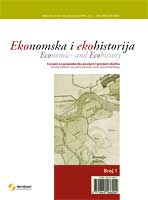UTJECAJ RIJEKE NA POGRANIČNA NASELJA - Primjer rijeke Drave u 18. i 19. stoljeću
INFLUENCE OF A RIVER TO BORDERLINE SETTLEMENTS - Case study of Drava river in 18th and 19th century
Author(s): Hrvoje PetrićSubject(s): History
Published by: Društvo za hrvatsku ekonomsku povijest i ekohistoriju - Izdavačka kuća Meridijani
Keywords: River Drava; environmental history; ecohistory; Borderline settlements; Podravina; River Drava regions
Summary/Abstract: Throughout the past centuries, Drava river in some parts of its flow was a borderline river. This features and qualities were most visible in late 16th century, when it became a dividing river between two empires - the Habsburg and the Ottoman Empires. This important quality was secured and kept until the end of 17th century. Later on, it became the borderline between the Croatian Military Border and Hungarian provinces, a status similar to the previous one it had been until the end of 16th century. This paper is limited to a concept of man and his environment in border area, but only in presenting certain aspects of complex relationship, on certain interrelations between the river Drava and people living along its flow. Recently, we are witnessing again that these regions are being depopulated once more. However, there is a possibility, that in different periods settlements were being established right along the river banks and disappearing again. Man’s influence on Drava has been visible from the first river regulation plans in 1780. This influence, however, became more significant only after early 19th century, or rather, from the first hydro regulation works of Drava river. On the other hand, for centuries Drava has influenced people in many ways. The following three examples are the best and most obvious direct indicators of these interrelations. The first example deals with resettlement of population from the left, to the right river bank (from Međimurje to Podravina region) - the Example of Legrad (1710). The second is partial destruction of a settlement, caused by Drava changing its flow and running through the settlement; hence, the population had to move and resettle from the right, to the left bank, forming a new settlement - example of Drnje partial destruction; this, in turn, cased two new settlements to emerge - Gotalovo and Gola (1820 - 1822). The third example is destruction of entire settlement and resettlement of townspeople to the same bank, but to an elevated location, somewhat further away from the river - the example of destruction of the settlement Brod and emerging of the new settlement Ferdinandovac (1844).
Journal: Ekonomska i ekohistorija - Časopis za gospodarsku povijest i povijest okoliša
- Issue Year: 2005
- Issue No: 1
- Page Range: 37-62
- Page Count: 26
- Language: Croatian

